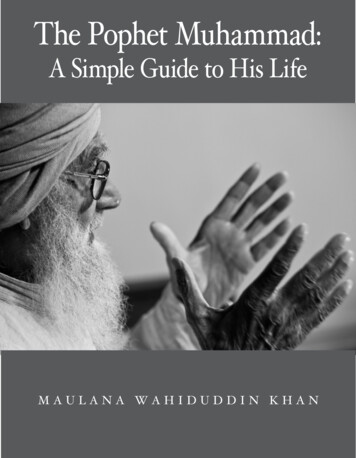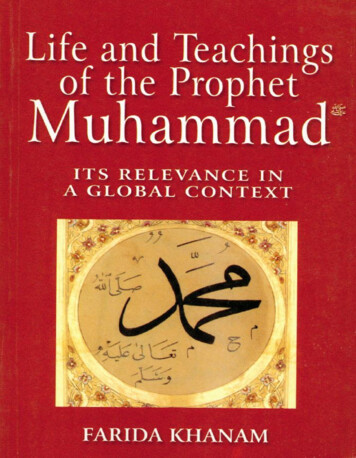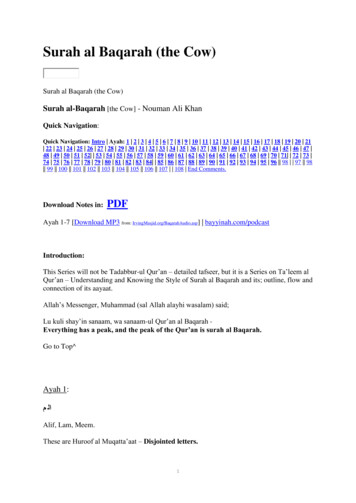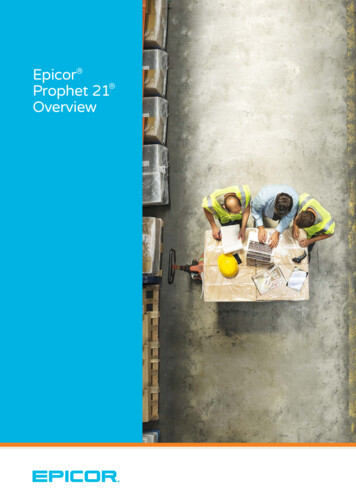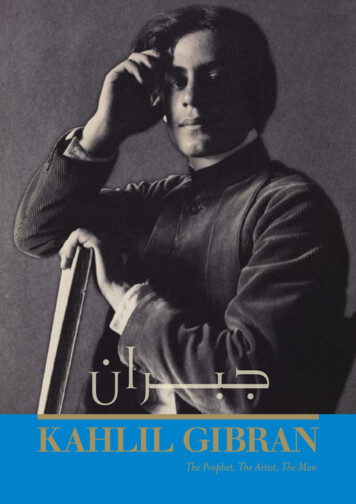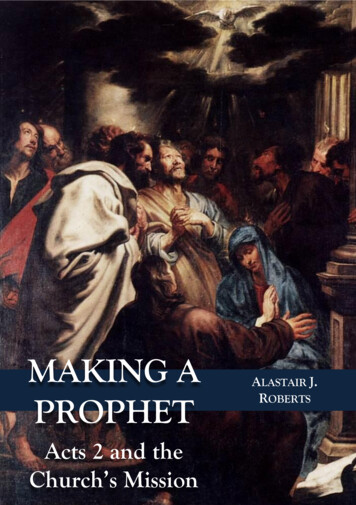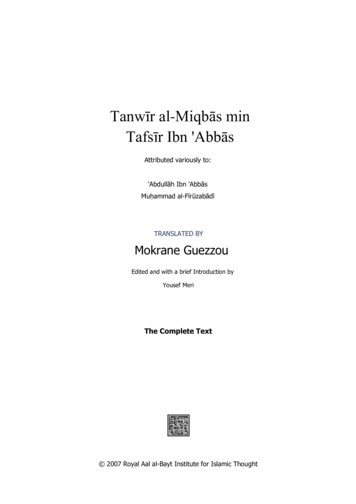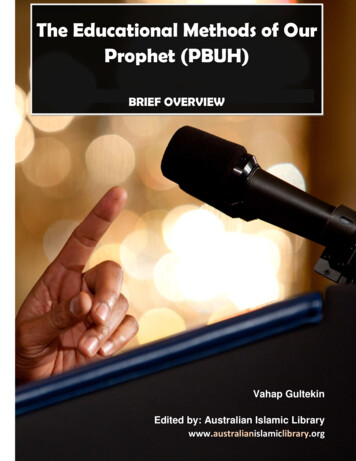
Transcription
The Educational Methods of OurProphet (PBUH)Australian Islamic Library www.australianislamiclibrary.orgBRIEF OVERVIEWVahap GultekinMethods of EducationEdited by: Australian Islamic Librarywww.australianislamiclibrary.org1
Australian Islamic Library www.australianislamiclibrary.orgMethods of Education2
Australian Islamic Library www.australianislamiclibrary.orgThis book is a brief overview of Prophet Muhammad (PBUH)’smethods of teaching and presents some pearls for the His wisdomwith regards to effective educational methods.Australian Islamic Library is honoured to have a complete bookshelfdedicated to this very aspect of blessed seerah. To access ourbookshelf on educational strategies and read books in multipleinternational languages, follow the link hing-skills.htmlAUSTRALIAN ISLAMIC LIBRARYFREE Islamic Education for All!Methods of Education3
Australian Islamic Library www.australianislamiclibrary.orgTABLE OF CONTENTS:The Educational Methods of Our Prophet (PBUH) . 5He rewarded and appreciated positive behaviours . 6He used to give examples suitable to the topic . 7He taught by practice . 8He used to explain making use of drawings . 9He used to repeat things . 10He made learners write . 10He used to criticize the BEHAVIOUR NOT THE AGENT . 11Methods of Education4
Australian Islamic Library www.australianislamiclibrary.orgThe Educational Methods of Our Prophet (PBUH)As a model in human relationships, the methods that the ProphetMuhammad (PBUH) used in spreading his cause and mission willprove to be effective if we can apply them successfully in our owneducational activities.What is more important than what we teach in education is how weteach it. Of course, we have to teach good and useful things to peopleand youth, but this must be done in effective ways. It is known thatthe students who do not like a teacher generally do not like thesubject either. A good educator should care about and love hisaddressee and he should be genial and positive; in fact, he shoulddevote himself to his profession and students.Our Prophet (PBUH) devoted himself to his duty. He had more of thequalities that an educator should have. Psychologists say that the wayyou speak is actually more important than what you say. Accordingto research, the words spoken contribute seven per cent of the effect;the tone of voice thirty-eight per cent; and the gestures and bodyMethods of Education5
Australian Islamic Library www.australianislamiclibrary.orglanguage have fifty-five per cent of the effect in communicationbetween people.The Prophet Muhammad (PBUH) was the most effective orator of allthe times. He knew how to address the hearts, and thus he becamethe beloved one of the hearts. He first made himself loved, and thensought the ways to educate people. He used a style in his speechesthat affected people and made them think, so he achieved permanentbehaviour change in people by means of the best educationalmethods. It is said that when prophet PBUH used to speak,companions would not move at all (because of their respect andimmersion in topic) as if there are birds sitting on their heads andwould fly away if they move. Such was the level of engagementbetween the best of the teachers (PBUH) and the best of the students.He rewarded and appreciated positive behavioursIf we want to lead people to behave positively and prevent them fromacting badly, the safest way to do this is to reward and appreciatepositive action.Methods of Education6
Australian Islamic Library www.australianislamiclibrary.orgTo be loved and appreciated is what people crave. In the process oflearning, people conclude from the appreciation and approval of theeducators what they are doing right and what they are doing wrong.Ibn Abbas (ra) tells: “One day I prepared some water in a pot so thatthe Prophet could perform ablution. When the Prophet saw the pot,he asked who had prepared it. Once he learned that it was me whohad prepared it, he prayed for me, “O Allah! Increase hisunderstanding in religion”. (Bukhari, Invitation, 19)He used to give examples suitable to the topicOne of the best methods of education is giving examples, as storiesand examples more stick in the mind. Man can look at the face of thetruth through these examples and stories and can perceive it moreeasily. The information given in the form of a story becomes moresignificant in the mind, and is remembered for much longer. Weshould read Islamic stories to our children, tell them about historicalevents and prefer to give all messages in form of stories. For thispurpose the Prophet (PBUH) highlighted the significance of theprayer with such a metaphor:Methods of Education7
Australian Islamic Library www.australianislamiclibrary.org“What would you say if there were a river in front of a man’s houseand he bathed in it five times a day, would he remain dirty?” Thosewho were there replied, “No, no dirt would remain on that man”.Upon this the Prophet (PBUH) said, “This is how it is with the fivedaily prayers. Allah (SWT) cleans sins by means of them.” (Bukhari,Mawaqit, 6; Tirmidhi, Adab, 80)He taught by practiceOne of the most effective ways of teaching is demonstrating by meansof practice. People do not forget what they are taught with practice.Teaching by practice is the most fruitful method of teaching. OurProphet (PBUH) saw a boy who was skinning a sheep and said tohim: “Let me teach you.” He put his hand between the skin and themeat until he reached up to the armpit of the sheep, and then he said:“Skin it like that, young man!” (Dawud, Taharat, 73; Ibn Maja,Zabaih, 6)Our Prophet showed a man who asked about it how to performablution. In some narrations it is said that he repeated it three times.(Ibn Maja, Taharat, 48)Methods of Education8
Australian Islamic Library www.australianislamiclibrary.orgTeaching by practice engages both the eyes and the ears, and thushelps the information to stick in the mind.He used to explain making use of drawingsAnother way of providing information which will stay permanentlyin the mind of the learners is to make use of drawings and figures.The right lobe of brain records drawings straight into thephotographic memory and it does not forget them for a long time. Forthat reason, teaching making use of drawings and visual methodsencourages the subject matter to be understood well. The ProphetMuhammad (PBUH) explained the features of the ways of Allah andSatan by drawing shapes on the ground while sitting together withJabir (ra). Jabir (ra) told the happening as follows: When I was sittingtogether with the Prophet, he drew a line in front of him and said,“This is it; this is the path of Allah (SWT)”. Then he drew two lines tothe right of this line and two lines to the left of the same line and said,“And these are the paths of the Satan”. Then he put his hand over theline in the middle and recited the following verse: “This is my straightpath, so follow it, and do not follow other paths, lest they scatter youfrom His Path. This He has enjoined upon you, that you keep fromdisobedience to Him in reverence for Him and piety to deserve Hisprotection.” (An’am, 6:153)Methods of Education9
Australian Islamic Library www.australianislamiclibrary.orgHe used to repeat thingsUnderlining and repeating the important points during teaching is animportant teaching method for making the subject matter remain inthe mind. The learner feels that what is repeated is important. To beable to memorize information, we repeat it. Through repetition theinformation is transferred from the short term memory to the longterm memory. Since the information is strengthened in the mind, itmay be easily recalled even if a long time passes. For this reason,when the Prophet Muhammad (PBUH) introduced new informationto his companions, he often used to repeat it three times and in thatway he tried to get the important points to stick in the mind. Also thenumber of repetitions could change according to the capacity of theinterlocutors. Some might get it when it was said just once and somemight need more repetitions. Anas (ra) said: “When the Messenger ofAllah said a sentence he used to repeat it up to three times makingsure that it was understood.” (Hakim)He made learners writeLearning by writing is one of the best ways of education. Whilewriting the attention is focused on the subject and you have a text ifyou want to remember the topic in a detailed way. Writing once isMethods of Education10
Australian Islamic Library www.australianislamiclibrary.orgequal to reading ten times. By writing, we engrave the topic both onthe paper and in our minds and hearts. The Prophet Muhammad(PBUH) said as follows regarding this issue: “Bind knowledge bywriting.” Furthermore, emancipation of the prisoners of the war inreturn for teaching literacy to people shows the significance that heattached to reading and writing. (Abu Dawud, Adab, 6)He used to criticize the BEHAVIOUR NOT THE AGENTThe Prophet Muhammad (PBUH) was sent to promote good morality.His words of advice were reflected from Allah who is theCompassionate as a reflection of mercy, thus, he would say goodwords and commit good deeds. He knew that evil words blemish theheart, and evil in the heart reflects upon the soul. For this reason, henever said an evil word to friend or foe. The Prophet would not speakin a way that would break anybody’s heart. When he was treatedbadly, he did not take it personally and he generalized it and thencorrected it. When someone complained to him about someone, or hesaw a fault in someone, he did not fling the fault in the agent’s face.Educationalists and psychologists say that for sustainable long-termeducation, a stable and uncritical relationship between teacher andlearner is a must.Methods of Education11
Australian Islamic Library www.australianislamiclibrary.orgWhen we look at our Prophet (PBUH), he would say, “what is thematter with those people that they say or do so and so!” and thus hemade people realize that what is wrong is the behaviour, and he didnot insult or scold people. He did not criticize the person, but ratherthe faulty action and he always did this correction in the best of ways.When we consider the life and practices of the Prophet (PBUH), werealize that applying his lofty methods can take us out of whateverdifficult situation we are in, solves all our problems, illuminates ourpaths and enhances our vision to be able to see the the farthest ofhorizons. We would be ultimate losers if we do not learn what he toldus and do not apply those pearls in our life.May Allah make us from them who earn His pleasure and not thosewho earn His wrath.Methods of Education12
that reason, teaching making use of drawings and visual methods encourages the subject matter to be understood well. The Prophet Muhammad (PBUH) explained the features of the ways of Allah and Satan by drawing shapes on the ground while sitting together with Jabir (ra). Jab
